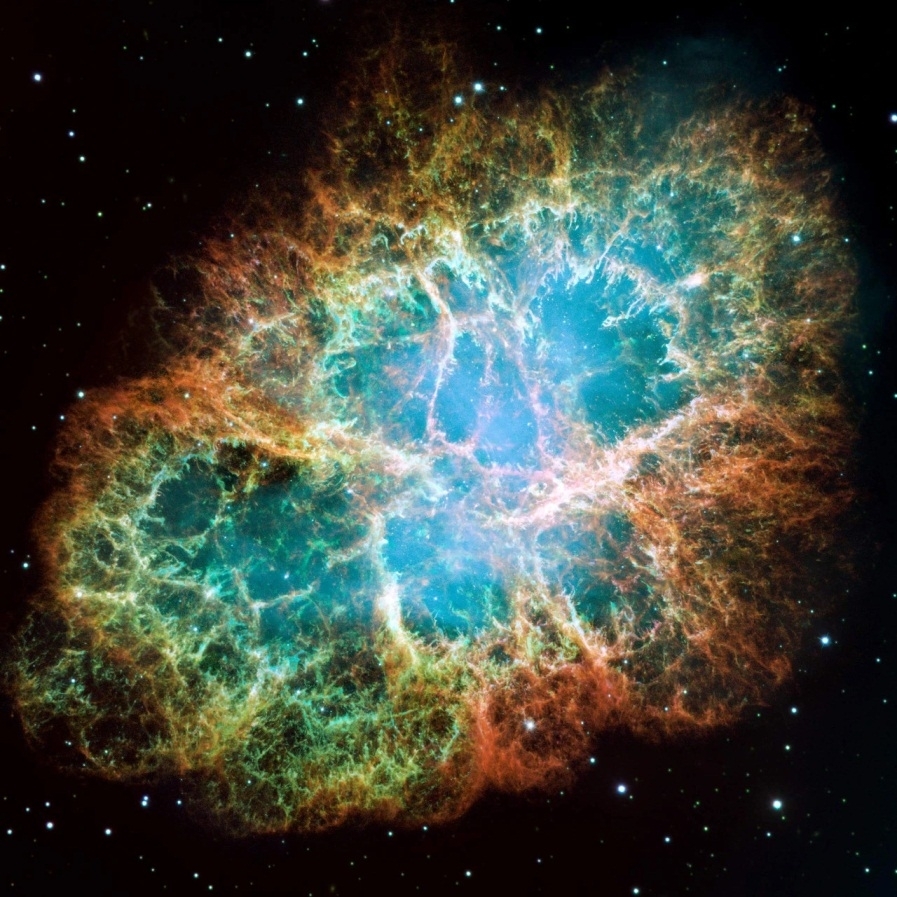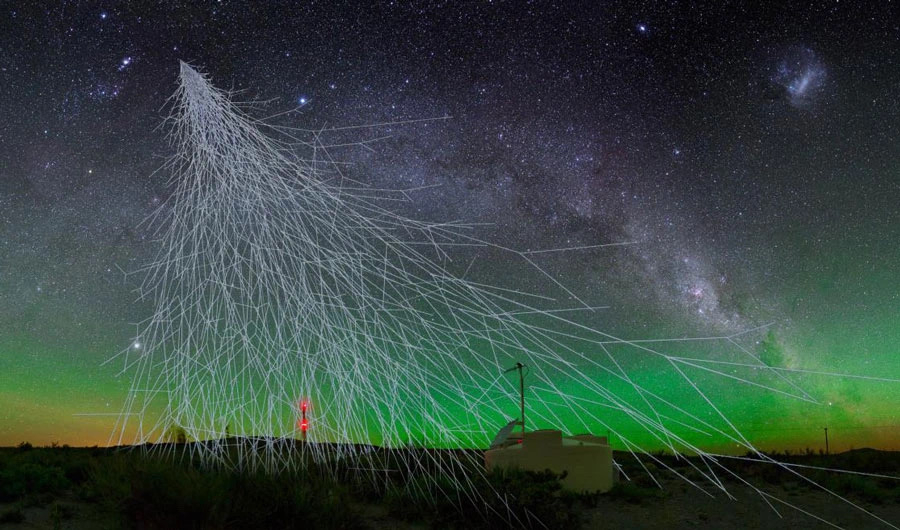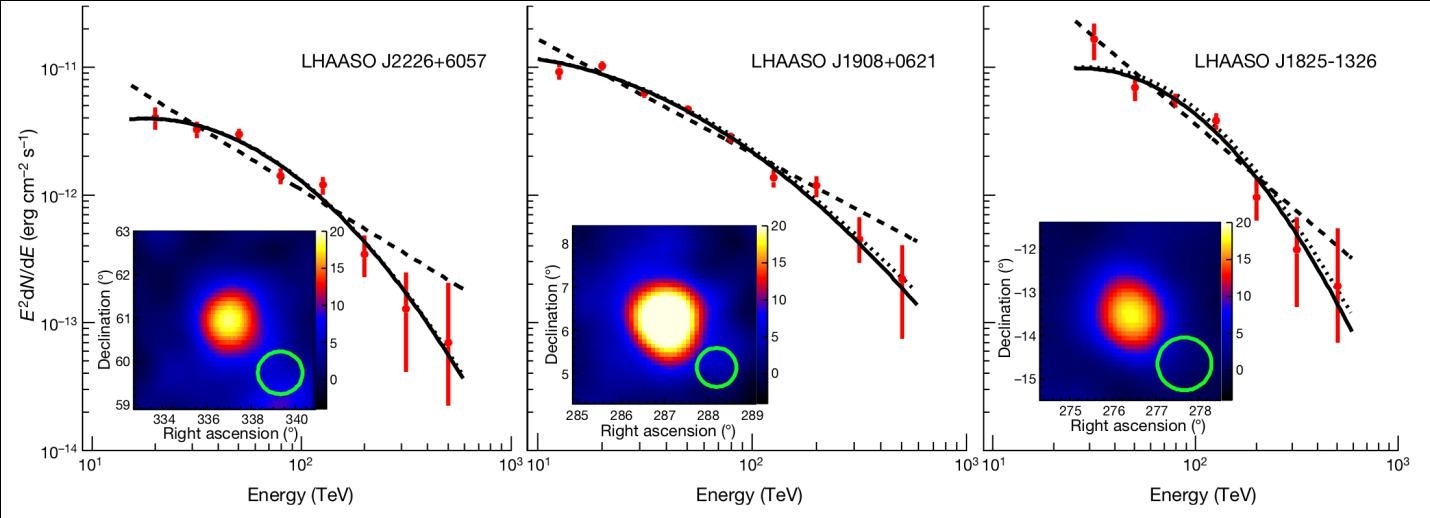By SONG Jianlan (Staff Reporter)

An international team led by researchers from the Institute of High Energy Physics, CAS has detected a total of 12 sources of ultrahigh-energy photons. Among them, the most powerful one – emitting photons of energies up to 1.4?1015 electronvolts – is found to be very likely located at the star-forming region in the constellation Cygnus. (Credit: IHEP)
Once again, the Crab Nebula fell in spotlight when an international team working on the Large High-Altitude Air Shower Observatory (LHAASO), a large ground-based array for cosmic ray detection, identified it as a source of ultrahigh-energy (UHE) photons, or gamma-rays. Actually, the team discovered a total of 12 UHE photon sources, with the most energetic one emitting photons at energies up to 1.4 petaelectronvolts (PeV, quadrillion or 1015 electronvolts), the highest ever detected by human beings. The large number of newly detected UHE gamma-ray sources, and the unprecedentedly high energy carried by the photons, soon ignited a new wave of passions for pursuing the origin of UHE cosmic rays (CRs), which has long puzzled the scientists. Particularly, touching on the “knee”, a peculiar bend at the UHE energy bands of CR spectra, the new results could also offer new clues for some cosmological issues of fundamental importance, and even new physics – a new world for human beings.
Based on the data collected over the past 11 months using the half-completed array, the LHAASO Collaboration, an international consortium led by the Institute of High Energy Physics (IHEP), CAS, reported May 17 in Nature that they caught more than 530 photons at energies exceeding 100 teraelectronvolts (TeV) and even up to 1.4 PeV. Subsequent analysis determined that the photons had come from 12 ultrahigh-energy (UHE) γ-ray sources, implying powerful particle accelerating mechanisms (accelerators) inside the sources; and the one that generated the 1.4 PeV photon is likely located in a very active star-forming region in the constellation Cygnus, the Cygnus Cocoon. The accurate locations of those accelerators were not identified, but all the 12 UHE sources, detected close to the Galactic Plane of the Milky Way, can be candidates for UHE CR “generators” – long-sought-after matrixes of violent physical processes emitting high energy particles.
“Our results indicate that cosmic accelerators capable of accelerating particles to energies exceeding 1 PeV are ubiquitous in the Milky Way,” says Prof. CAO Zhen, researcher with the Institute of High Energy Physics, Chinese Academy of Sciences, co-corresponding author of the Nature Paper. “All the gamma-ray sources that LHAASO has effectively observed radiate photons in the UHE range above 0.1 PeV, indicating that the energy of the parent particles radiating these gamma rays must exceed 1 PeV,” he adds.
What has happened in these extremely powerful CR generators, termed “PeVatrons”? What kind of physical processes could be powerful enough to have ejected and driven the cosmic particles all the way here? Unfortunately, no one knows yet with good certainty, despite the century-long quest for answer; even the existence of such cosmic accelerators in our galaxy had been evasive.

The Crab Nebula (Credit: NASA, ESA, J. Hester and A. Loll (Arizona State University)
Evasive Particles
UHE CRs are actually atomic nuclei, like protons and iron nuclei, and very tiny fraction of electrons, photons and neutrinos, flying at velocities approaching the speed of light. As a cosmic messenger, they could carry some secrets from the depth of the universe – the physical processes that have produced them, and everything they encountered on the way here to the Earth could have left some imprint on them, and hence the studies of them can help us pursue some physics issue of fundamental importance, like the evolution of the universe, the motion and interaction of high-energy astronomical celestials, and the nature of dark matter.
However, even the sources of these particles are difficult to track. Since Francis Victor Hess first unveiled their existence in 1912, the century-long search by the astrophysical community has only returned very few candidate UHE sources. After all, CRs propagating at such high energies are very scarce – the higher the energy goes, the less the flux of CRs detectable from the ground. At the level of PeV, only one or two CRs could fall on the ground within an area of 1 square meter per year. This very low occurrence rate makes it impossible to detect them from space, where only small-scale detectors can be sent. Therefore, UHE particles can only be picked up by large-scale and extremely sensitive ground-based instruments. Even worse, such particles can be absorbed by the Earth’s atmosphere, therefore the instruments located at low-altitude areas could simply miss out their trails. Moreover, the majority of such particles are electrically charged, and hence on their flight they could be deflected repeatedly by the magnetic field diffusely distributed everywhere in our galaxy – this means, before arriving to the Earth, they have long lost the “memory” about their origins.
To track the origin of these fleeting cosmic particles, scientists turn to UHE photons, or gamma-rays, for help. Photons do not carry any electric charge, therefore can escape the influence of the magnetic fields all through their way here to maintain the original direction from which they have come over. More excitingly, according to mainstream models explaining CR origins, gamma-rays can rise from somewhere in the proximity of the “CR factories” as a result from the interactions between the CR particles and the surrounding gases, and hence can work as a tracer for CRs. Gamma-rays can even work as a measure for the energies of the protons in acceleration, because as calculated by such models, they carry about one tenth of the energies of their father particles – the high-speed protons emitted from the CR factories.
It is not easy, again, to pick up such faint, dim signals at UHE bands from the ground; and previous mainstream detectors mostly work below this energy range. Thankfully, resulting from their long exploration, scientists have developed two parallel observational methods to meet this goal: detecting UHE CRs via the observation on extended air showers (EAS) triggered by the particles, or via the observation on a particular type of light called Cherenkov radiation, which is produced by flows of superhigh-speed particles bumped out by gamma-rays hitting on the upper atmosphere.

An artistic illustration of EAS, the cascade amplification of a chain reaction triggered by a cosmic-ray particle. (Credit: A. Chantelauze/S. Staffi/L. Bret)
The LHAASO, comprised of three interconnected detector arrays, namely the Water Cherenkov Detector Array (WCDA), the Kilometer Square Array (KM2A) and the Wide Field-of-view Cherenkov Telescope Array (WFCTA), applies both methods. Situated on the Mount Haizi of Daocheng County, Sichuan Province in China, its altitude at 4,410 meters above sea level puts it in a prime situation to receive the EAS signals.

Aerial photograph of LHAASO (Image by IHEP)
Collecting the “Raindrops” from a Cosmic Shower
EAS is formed by clusters of very-high-energy particles produced by the chain reactions triggered by CRs with the atomic nuclei in the upper atmosphere. Such a “shower” of high-energy particles, as the cascade amplification of CR signals, can spread up to cover an area of several square kilometers, and reach a prime flux for observation at altitudes 4,000 to 4,500 meters above sea level. Due to their ultrahigh energies, they move at a super velocity of light to approach the Earth surface and soon vanishes when dropping deep into the atmosphere.
Collecting “raindrops” from these showers and measuring their parameters can help us understand the properties of the CRs that have given rise to them, and help reconstruct the physical progress that have produced these mysterious high-energy particles.
PeV photons are so scarce, that merely one or two of them can be detected from a source like the Crab Nebula within a year, even using an array spanning across an area of 1 km2. Even worse, these very dear photons would just arrive in a mixture with tens of thousands of ordinary CR particles. To pick up and record these weak signals, an instrument has to reduce its background noise to the minimum. To meet this end, the KM2A of LHAASO is designed with an array of 5,195 electromagnetic particle detectors together with an array of 1,188 muon detectors. By collecting muon mesons, a type of penetrating sub-atomic particles, from a huge underground water Cherenkov detector array can help scientists separate atomic nuclei in the CR particles from photons, therefore greatly reduce the “background noise” and increase the system’s sensitivity.
Both the nuclei particles and the photons can trigger chain reactions with the air molecules; but different ones. Compared with the chain reaction (or a CR event) triggered by an atomic particle, the event initiated by a photon produces much less muons. By collecting the muons and recording their parameters like incidence angles, scientists can tell the EAS events triggered by ordinary CRs from those by photons. On the other hand, the data from different arrays can cross verify with each other to secure the reliability, and further reduce the background noise.
The vast collecting area of its arrays, the smart design and the prime altitude altogether make LHAASO the most sensitive instrument for photon detection so far, and it is predicted to maintain this excellency for one or two decades. According to the authors, the full array of LHAASO can detect a tiny flux as weak as to the 10-14 erg cm-2 s-1 level, substantially below the thresholds of other current and planned gamma-ray detectors working at PeV energies.

The LHAASO is designed with three major arrays of detectors. Located 4,410 meters above sea level on the Mt. Haizi in Daocheng County, Sichuan Province and covering an area of about 1.36 km2, its construction is expected to be completed in 2021. Its complete arrays will include the 5,195 electromagnetic particle detectors and 1,188 muon detectors installed in the square-kilometer complex array (KM2A), the 78,000 m2 Water Cherenkov Detector Array (WCDA), and the 18 telescopes in the Wide-Field-of-View Cherenkov Telescope Array (WFCTA). Combining these four detection techniques, LHAASO will be able to measure cosmic rays omnidirectionally with multiple variables simultaneously. (Credit: IHEP and Nature)

The telescopes in the Wide-Field-of-View Cherenkov Telescope Array (WFCTA). Each of them can be tuned 0~90 degrees in elevation to effectively target on the goals. (Credit: IHEP)
‘The LHAASO layout consists of an impressive assembly of many traditional instruments equipped with advanced technology devices. The combination of “brute force” and technology at the edge of that currently available gives LHAASO an outstanding and unprecedented sensitivity to detect high-energy gamma rays,’ comments Benedetto D’Dttorre Piazzoli, former Vice President of the National Institute of Nuclear Physics of Italy.
The excellent performance of LHAASO makes it possible to detect the PeV photons, approaching the upper end of the spectra for detectable cosmic rays, touching on the “knee”, hence tearing open a small peephole on the solid “wall” stopping us from seeing through the cosmos.
The “Knee” and “PeVatrons”
The UHE compositions of CRs draw much attention from scientists, as the former must have resulted from very extreme physical processes. How are they produced, how have they gained such high energies? Their stories might open a window on the possible violent physical processes at the heart of the universe, shedding light on some fundamental issues in cosmology. More interestingly, they form a peculiar bend – dubbed the “knee” – on the full CR spectra, just like a mysterious cryptogram.
The full spectra of detectable cosmic rays cover a wide range of energies spanning from 109 to 1020 eV, where the higher the energy goes, the less the flux detected. At energies from 100 GeV (1 GeV=109 eV) to 100 EeV (1 EeV=1018 eV), the spectra, regardless of their corresponding particle compositions, follow a power law very well, with the power exponent maintaining at around 2.7. When the energy approaches PeV level, however, the slope turns steeper, with the power exponent increasing to about 3.1, making a mild turn in the shape of a human knee. More surprisingly, different experiments around the world, regardless what particle they target on, all have detected this structure, though the exact energies at which the “knee” manifests vary with particle compositions and instruments.
What have contributed to the abrupt change in the decreasing rate of flux? So far physicists have no clear answer, though they agree that it could have arisen from different mechanisms involved with the sources of the particles, their propagation across the vast interstellar medium to get to the Earth, or/and the interactions between particles from different sources – for example the reactions between particles from the Milky Way and those of extragalactic origin.
The pursuit for knee physics has to answer first how the particles are accelerated to such high speed, or in other words, how they have gained this high energy. Different models for particle acceleration have been proposed to explain this. Some argue that the shock waves resulting from a supernova outburst can meet the requirements to become a PeV proton accelerator; some propose that highly magnetized and fast-rotating massive stars (pulsars) can also do this job. Such astrophysical mechanisms that can speed up CRs to PeV energies are termed PeVatrons by astrophysicists, comparing them to the Tevatron, a man-made accelerator used to be operative at the Fermi Lab near Chicago, Illinois, the USA.
Such models have not without opponents. Some physicists insist that given the limited lifetime of the shock waves in the wake of a supernova explosion, protons are very hard to reach PeV energies. To verify or falsify such models, astronomers have to find out observational evidence; hence gamma-ray sources that eject photons beyond 0.1 PeV, or proton sources with energies beyond 1.0 PeV have been earnestly sought after. Their exact locations, if accurately determined, would be able to help us connect the UHE particles with their host celestial bodies, and hence better understand the physical nature of these CR origins.
After searching for decades, scientists only managed to find the first evidence for a proton PeVatron a couple of years ago. The HESS Collaboration reported clear evidence for its existence in March 2016, attributing it to the supermassive black hole Sagittarius A* of the Galactic Centre.
The following years saw more encouraging progress. A joint team of Chinese and Japanese scientists working on the Tibet ASgamma Experiment, an astronomical instrument also hosted by IHEP, detected photons with energy beyond 0.1PeV from the Crab Nebula in 2019 after updating the array to significantly improve its sensitivity. This marked the first photon PeVatron ever detected. Further, early April this year witnessed the successful determination by the same experiment of the existence of diffusive PeVatrons in the Milky Way.
Now the LHAASO, a third-generation CR observatory, took over the lead.
Using the merely half-completed array, the international collaboration reported new discoveries from their past 11 months’ observations, not only confirming the earlier results from the Tibet ASgamma Experiment, but also extending the detection of photons to energies beyond 1PeV, touching on the “knee”.
CR Origin in Mist
“For the results presented in the published Nature article, we claim the first unbiased and unambiguous discovery of both electron and proton PeVatrons,” says Prof. Felix Aharonian, a renowned astrophysicist from the MaxPlanck Institute for Nuclear Physics and co-corresponding author of the Nature paper. “At least one source from the published list – the Crab Nebula – operates as an electron PeVatron, and at least one source – the Cygnus Cocoon – is powered by a proton PeVatron,” he stresses. “The gamma-ray spectra of both objects continue to and beyond 1 PeV.”
Nevertheless, so far none of the PeVatrons detected can be firmly connected to shock waves in the wake of supernova explosions as predicted by the “standard model” for UHE CRs.
“But what we can say for sure is that PeVatrons do exist in the Milky Way, and these findings bring us closer to understanding the origins of extremely high energy cosmic rays,” comments Karl Ziemelis, Chief Physical Sciences Editor for Nature.
“The discovery of a large number of UHE photon sources might inspire the research on CR origin in different ways,” comments Prof. CUI Wei, astrophysicist from the Department of Astronomy at Tsinghua University. “With the detection of PeV gammas LHAASO provides nearly model-independent evidence for the presence of proton accelerators in astronomical sources. Previous observations with Cherenkov telescopes had already yielded good evidence for such, but the observations could be explained with an electron or a proton origin equally well,” he continues. “Their discovery has encouraged the search for their counterparts in visible light or radio bands, and this will in turn help the identification and research of CR accelerators.”
As for the general origin of CRs, the century-long mystery, some scientists predicted that supernova remnants (SNRs) suffused with gases could be a promising type of candidates, but so far it still needs support with clear, unbiased evidence from observations. Actually, the fact that the source for the most energetic photons lies in the Cygnus Cocoon, a star-forming region, suggests that at the UHE band and beyond, things might be different.
“The LHAASO Collaboration did not see any in the 12 sources that could be firmly identified with supernova nebula remnants (SNRs), which have been predicted by some as the main contributors to the Galactic CRs up to the so-called knee around 1 PeV,” introduces Prof. Felix Aharonian. “Clusters of young, very massive stars should be considered a serious alternative or addition to SNRs,” he suggests.
Scientists have also long been wondering if the Crab Nebula, a pulsar wind nebula, is a source of cosmic rays. And yes, the authors analyze, under some certain conditions it could be a possible source for the protons. “If confirmed, this would be the first strong evidence of acceleration of PeV protons by a supernova remnant,” say the authors in the paper.
Welcome an Unexplored “UHE Universe”
For over 30 years, a theory has prevailed in the circle of very-high-energy gamma astronomy: the CR flux would be “cut off” at energies around 0.1 PeV, signaling the upper limit for cosmic accelerators within the Milky Way. According to this theory, no nuclei particle within the Milky Way could be accelerated to an energy beyond this limit, though CR flux extends to much higher energies. The results from LHAASO, however, increased this previously predicted limit. The team found that the spectra of most detected sources are not truncated.
“We were happily surprised,” recalls Prof. CAO. “Almost any a known gamma-ray source, as long as its flux strong enough for LHAASO to pick up, emits powerful gamma rays up to 0.1 PeV and beyond, displaying a brand-new universe. A new window onto this UHE universe has been open!”
At least at the PeV energy range, the team did not find the “cutoff”. Instead, they clearly caught the “knee”, the bend where the decreasing rate of CR flux gradually turns steeper. This turn, analyze the authors, could have partially produced by the gamma-gamma absorption that occurs when the photons interact with the diffuse far-infrared and microwave radiation fields.

The knee-like structures on the spectra of three UHE sources detected by LHAASO (Credit: IHEP and Nature)
‘As a matter of fact, cosmos is not “transparent” any more for gamma rays from PeV and beyond,’ explains Prof. CAO. “Any charged particles with energies beyond 70,000 PeV or photons beyond 1 PeV could be absorbed by the microwave background radiation, the residual of the Big Bang, after certain path length. If this theory stands, PeV would be the ultimate limit for the high energy cosmic exploration, and any discovery breaking through this limit would be breath-taking – because this could shake some very fundamental physics principles. Now you understand what this means for astrophysics: it is really cutting the edge,” adds CAO, overwhelmed with joy.
‘With the completion of LHAASO and the continuous accumulation of data, we can anticipate to find an unexplored “UHE universe” full of surprising phenomena,’ CAO shares his expectations of the instrument.
Prof. CUI also feels encouraged by LHAASO’s success in detecting electron/proton PeVatrons. “The more energetic the detected photons, the more powerful can be the cosmic particle accelerators, and the better the chances are to find evidence for new physics,” he explains. “The higher the energies, the more extreme the conditions must be in the celestial body that has produced the photons, and these extreme conditions would be a hotbed for new physics phenomena.”
“Over the last two decades, we have seen two revolutions in gamma-ray astronomy: First, in GeV energy band thanks to the Fermi gamma-ray satellite mission; and second, at TeV energies after the exploitation of the full potential of the so-called Imaging Atmospheric Cherenkov technique,” remarks Prof. Felix Aharonian. “These days we are witnessing a new revolution, this time in the UHE, above 100 TeV, band. One can predict with confidence that for the next ten years (at least), LHAASO will dominate in the field and play the major role in the upcoming developments,” he continues.
“Finally, let me conclude with a statement that the results reported in the Nature article reveal only the tip of the iceberg,” insists Prof. Aharonian. “In the coming years, we anticipate breakthrough discoveries by LHAASO that could dramatically change the current concepts about the most energetic and extreme phenomena in the non-thermal Universe.”
Reference
Amenomori, M. et al. (Tibet ASγ Collaboration) First detection of photons with energy beyond 100 TeV from an astrophysical source. Phys. Rev. Lett. 123, 051101 (2019).
Amenomori, M. et al. (Tibet ASγ Collaboration) First Detection of sub-PeV Diffuse Gamma Rays from the Galactic Disk: Evidence for Ubiquitous Galactic Cosmic Rays beyond PeV Energies. Phys. Rev. Lett. 126, 141101 (2021).
Cao, Z., Aharonian, F.A., An, Q. et al. Ultrahigh-energy photons up to 1.4 petaelectronvolts from 12 γ-ray Galactic sources. Nature 594, 33–36 (2021). https://doi-org-443.webvpn.las.ac.cn/10.1038/s41586-021-03498-z
HESS Collaboration. Acceleration of petaelectronvolt protons in the Galactic Centre. Nature 531, 476–479 (2016).
Huentemeyer, P. Hunting the strongest Accelerators in Our Galaxy. Nature 594, 30–31 (2021).

